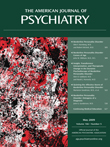Metabolic Changes Associated With Second-Generation Antipsychotic Use in Alzheimer’s Disease Patients: The CATIE-AD Study
Abstract
Objective: The second-generation antipsychotics are associated with metabolic abnormalities in patients with schizophrenia. Elderly patients with Alzheimer’s disease are frequently treated with these antipsychotics, but limited data are available on their metabolic effects. Method: The authors assessed 186 male and 235 female Alzheimer’s disease outpatients from the Clinical Antipsychotic Trials of Intervention Effectiveness–Alzheimer’s Disease (CATIE-AD) for changes in weight, waist circumference, blood pressure, fasting glucose, and lipids in relation to duration of second-generation antipsychotic use (i.e., olanzapine, quetiapine, and risperidone) throughout the 36-week trial, using logistic regression and mixed-effects models. Results: Women showed significant weight gain (0.14 lb/week of use) while change was nonsignificant in men. Clinically significant weight gain (i.e., ≥7% of body weight) was seen among patients with antipsychotic use ≤12 weeks (odds ratio [OR]=1.56, 95% CI=0.53 to 4.58), between 12 and 24 weeks (OR=2.89, 95% CI=0.97 to 8.64), and >24 weeks (OR=3.38, 95% CI=1.24 to 9.23) relative to patients who did not use antipsychotics during the trial. Olanzapine and quetiapine treatments were significantly associated with weight gain (0.12 and 0.14 lb/week, respectively). In addition, olanzapine was significantly associated with decreases in HDL cholesterol (–0.19 mg/dl/week) and increased girth (0.07 inches/week) relative to the placebo group. No treatment effects were noted for changes in blood pressure, glucose, and triglycerides. Conclusion: Second-generation antipsychotic use was associated with weight gain in women, with olanzapine and quetiapine in particular, and with unfavorable change in HDL cholesterol and girth with olanzapine. The potential consequences of these effects suggest that patients with Alzheimer’s disease treated with second-generation antipsychotics should be monitored closely.



